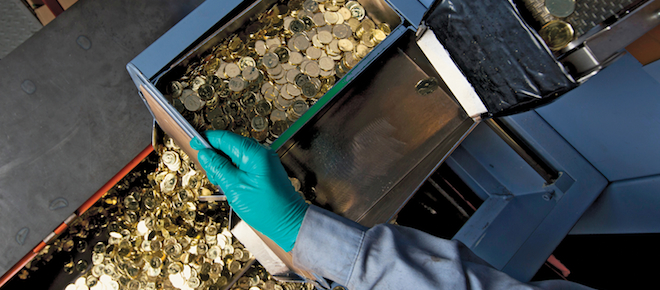What’s up with the soaring loonie?
The loonie’s rise is creating headaches for the Bank of Canada
Canadian one dollar coins, also known as Loonies, fall into a container at the Royal Canadian Mint in Winnipeg, Ontario, Canada, on Friday, July 5, 2013. The Canadian dollar rose from its lowest level in almost two years before a report tomorrow forecast to show the pace of home construction in June stayed above the year-to-date average for the second month in a row. Photographer: Brent Lewin/Bloomberg via Getty Images
Share

This post originally appeared at BusinessInCanada.com
The Canadian dollar is on a tear.
After a surprisingly firm inflation print for May brought the headline rate above the midpoint of the Bank of Canada’s target range, and manufacturing data from China beat expectations, the loonie is trading at about 0.932 against the greenback—a five-month high (as of publishing).
That’s a far cry from the four-and-a-half year lows the loonie was plumbing in late March, down below 89 cents relative to the U.S. dollar.
Even after this brisk rally, the Street is warning that there may be further appreciation to come in the near future as the “short CAD” trade unwinds. “We would not recommend long CAD as a medium-term trade, given that the Bank of Canada is set on maintaining a dovish policy bias, but the near-term potential for CAD upside seems compelling,” writes Société Générale’s Alvin Tan, who notes that the speculative positioning in the loonie remains short.
In mid-May, Gluskin Sheff chief economist David Rosenberg said there were two words that explained the decline in the Canadian dollar seen over the past year: Stephen Poloz. “The Bank of Canada governor has been rather vocal over the need for the Canadian economy to rebalance via less reliance on consumer spending and housing and more on exports,” he wrote.
Poloz, for his part, has suggested on a couple of occasions that the downward trend could be attributed to increased optimism about economic prospects south of the border—that it was the U.S. half of the pair pushing the Canadian dollar lower. The data, however, do not fit the governor’s narrative.
In fact, there are three words that explain the Canadian dollar’s depreciation in the second half of 2013 and early 2014 and the rebound that followed: Poloz, inflation, and oil.
Consider this annotated chart of the Canadian dollar trade-weighted index (CERI) since the governor took the reins at the Bank of Canada:
The first two words–Poloz and inflation–go hand-in-hand. Though the governor has never explicitly talked down the loonie, there is no doubt that the Bank of Canada’s openness to a rate cut in light of persistently low levels of inflation was the driving force behind the decline in the currency.
Poloz did away with the year-and-a-half old tightening bias. And after repeated warnings from the Bank of Canada that the downside risks to inflation were assuming increasing importance, traders started to seriously consider the possibility that a rate cut might be in the offing, increasing the downward pressure on the Canadian dollar.
Then, abruptly, the primary condition that caused the governor to turn dovish—the disinflationary trend—began to reverse. It’s not shocking that the upside surprise to inflation in February broke the Canadian dollar’s slide. Traders had already begun to figure out that the probability of a rate cut in 2014 was significantly lower than they had thought at the beginning of the year. That print was proof that after years of overestimating inflation, the Bank of Canada had finally erred on the low side.
However, there was also a more fundamental basis for the loonie’s twists and turns: the fluctuations in Canada’s terms of trade. That’s where oil comes into the equation:
Historically speaking, there is a loose but reliable connection between the price of crude oil and the value of the loonie. During a speech in Saskatchewan in April, the governor explained this “loose, but dependable” relationship between the Canadian dollar and the terms of trade (read: oil) in typical Polozian style–with an analogy:
For Canada as a whole, where the terms of trade go, the loonie follows. International investors buy good-news stories and, when they buy Canada’s, the value of the Canadian dollar goes up. As a consequence, our terms of trade and the dollar move together, although not necessarily always in sync. It’s like walking a dog on one of those leashes that stretch out and snap back. You might hope he’ll stick by your side, but in reality the dog is always off in all directions. By the end, your respective tracks zigzag all over the place, much like an economist’s chart. But when you leave the park, you’re still together.
In the second half of 2013, all of the loonie’s drivers were pushing the currency in the same direction. Inflation was on the decline, oil was falling, and the Bank of Canada was sounding incrementally more dovish in each policy statement. Now, inflation is rising, oil has surged, and Poloz & Co. have struggled to explain why the downside risks to inflation remain as important as before.
During the first quarter of 2014, firmer than anticipated readings of inflation weren’t having much of an impact on the Canadian dollar. The governor emphasized that temporary factors – high energy prices and exchange rate pass-through – were providing upward pressure on the headline rate, and indicated that the Bank would be keeping a closer eye on core inflation, which continued to linger well below two per cent as of its latest policy statement.
That all changed on Friday, June 20, when May’s inflation data were released and the loonie subsequently spiked. Core inflation appears to be trending back towards its ideal level of 2 two per cent, and traders seem to have finally rebelled against the Bank’s messaging, or at the very least, have closed up their shorts en masse.
Market participants are no longer ignoring or downplaying the rise in inflation.
How long can monetary policy-makers continue to?

